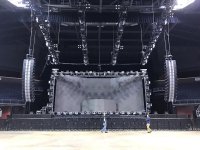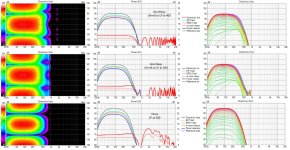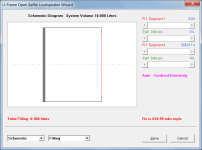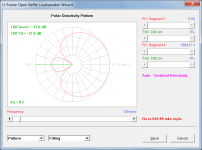this thread on ASR shows results of several ABEC simualtions of dipoles, H and U frames in which the magnet structure seems to be modelled
U-frame simulations on ASR
EVERYONE GO READ THAT LINK
So much fantastic info in there.
I personally built a u-frame array, and had no idea that the concept was so fundamentally flawed: https://www.diyaudio.com/community/threads/nehalem.396920/
There are no room modes a couples of octaves above subwoofer region?
Of course there are - but multisubs cannot address them because they basically don't play there. That's why an alternate excitement pattern is potentially (not always!) beneficial.
In the subwoofer passband IMO nothing beats multisubs. Other approaches burn headroom and sacrifice tactility for...I'm not sure what, exactly. But above that it's worth experimenting.
If you have access to the good versions of Dirac (DLBC or ART) they offer a visual called "spread." to represent mean spatial variance across measured positions. With DLBC and multisubs you see a pretty tight "spread" in the subwoofer passband, and then it blows up again in the next couple octaves. With ART you can get a pretty tight spread up to the top end of its passband (though this is blunted by the 150Hz ceiling in current commercial applications; we'll see in the future).
Active room correction is also not the right way at those higher frequencies.
Move your head a couple of inches and it's all gone.
That's not my experience when using the tools correctly. Besides, I'd like to see data showing that moving "a couple of inches" results in drastically different steady state in room response below say 500Hz.
Are cardioids more effective than the leading edge of room correction? I literally know nobody who has truly done the comparison. Maybe there is an Dirac ART beta tester or StormAudio owner who uses DIY cardioids, or Dutch & Dutch/Kii, who could opine on that. But I've spoken to such person or seen that written up anywhere.
A couple of observations:
When I lived in Oregon, I did a bunch of multisub setups, culminating in one where I basically built a raised floor with something like ten subwoofers. It was a quasi infinite baffle, basically my couch sat on this raised surface and the subs fired up. To no one's surprise, I generally found that what Geddes recommends worked the best. (A handful of subs, EQ'd and time aligned.) Possibly one of the most eye opening discoveries was that varying the height of one sub really made a big difference. I had one of those Ikea Kallax shelves that I was using as a room divider, and putting one sub about 1.5 meters above the floor did wonders. I noticed with the multisub approach that you can't localize the bass, it just seems to envelop you. Sounds very very different than a single or double sub setup.
For about half of this year, I tried a multisub approach with dipoles. I did a lot of measuring and found that the orientation of the subs made a huge difference. Once again, the best location in the entire room was off the floor. I wound up putting two subs about 1.75 meters off of the floor.
The thing that was interesting about the dipole subs was:
1) it was shockingly easy to get them to play down to 20Hz. My main listening room is my office, and in that small space, just 350 watts and three subs was plenty of power to get down to 20hz. I never would have imagined this in a million years; in my home theater I had a sealed sub with 1000 watts and dual high excursion fifteens, and was NEVER able to get down to 20hz without it sounding terrible.
2) Even when playing fairly loudly at 20hz, there was just no impact at all. None. Nada. I notice the same thing when I break subwoofers in with sine waves; woofer cone moves, there's a faint perception of higher frequency harmonics, but you can't really tell that's it's playing 20Hz
I think the reason that my mammoth dual fifteens sounded terrible playing 20Hz is that they're REALLY shaking the house, and hearing the walls crack is kinda neat for about a minute, but it's SUPER ANNOYING in the long term. With one or two subs, you get some really strong room modes, and that can definitely make the walls shake, and not in a good way. I live in a four year old house and new construction is really flimsy.
My preference is definitely for multisubs. I like the "envelopment" and because the room modes are spread out, you don't flex the walls in the same way. Back in the day I made a 10Hz tapped horn with two high excursion twelves, and you could literally feel the wood bending from the high pressure zones in the tapped horn; dual fifteens and a thousand watts do the same thing to the entire room.
I'm on a prosound forum on Facebook, and something they've observed there is that a lot of audiences aren't super keen on the sound of cardioid subs. They don't "hit" the same way. I used to see them at EDM shows fairly often, but most of the shows I've been to in the last five years, they've switched to horizontal arrays of subs. Basically a line array of subwoofers flipped on it's side, so you get a wall of bass that produces a narrow wavefront down to 20hz (17 meters)
When I lived in Oregon, I did a bunch of multisub setups, culminating in one where I basically built a raised floor with something like ten subwoofers. It was a quasi infinite baffle, basically my couch sat on this raised surface and the subs fired up. To no one's surprise, I generally found that what Geddes recommends worked the best. (A handful of subs, EQ'd and time aligned.) Possibly one of the most eye opening discoveries was that varying the height of one sub really made a big difference. I had one of those Ikea Kallax shelves that I was using as a room divider, and putting one sub about 1.5 meters above the floor did wonders. I noticed with the multisub approach that you can't localize the bass, it just seems to envelop you. Sounds very very different than a single or double sub setup.
For about half of this year, I tried a multisub approach with dipoles. I did a lot of measuring and found that the orientation of the subs made a huge difference. Once again, the best location in the entire room was off the floor. I wound up putting two subs about 1.75 meters off of the floor.
The thing that was interesting about the dipole subs was:
1) it was shockingly easy to get them to play down to 20Hz. My main listening room is my office, and in that small space, just 350 watts and three subs was plenty of power to get down to 20hz. I never would have imagined this in a million years; in my home theater I had a sealed sub with 1000 watts and dual high excursion fifteens, and was NEVER able to get down to 20hz without it sounding terrible.
2) Even when playing fairly loudly at 20hz, there was just no impact at all. None. Nada. I notice the same thing when I break subwoofers in with sine waves; woofer cone moves, there's a faint perception of higher frequency harmonics, but you can't really tell that's it's playing 20Hz
I think the reason that my mammoth dual fifteens sounded terrible playing 20Hz is that they're REALLY shaking the house, and hearing the walls crack is kinda neat for about a minute, but it's SUPER ANNOYING in the long term. With one or two subs, you get some really strong room modes, and that can definitely make the walls shake, and not in a good way. I live in a four year old house and new construction is really flimsy.
My preference is definitely for multisubs. I like the "envelopment" and because the room modes are spread out, you don't flex the walls in the same way. Back in the day I made a 10Hz tapped horn with two high excursion twelves, and you could literally feel the wood bending from the high pressure zones in the tapped horn; dual fifteens and a thousand watts do the same thing to the entire room.
I'm on a prosound forum on Facebook, and something they've observed there is that a lot of audiences aren't super keen on the sound of cardioid subs. They don't "hit" the same way. I used to see them at EDM shows fairly often, but most of the shows I've been to in the last five years, they've switched to horizontal arrays of subs. Basically a line array of subwoofers flipped on it's side, so you get a wall of bass that produces a narrow wavefront down to 20hz (17 meters)
Attachments
Models are not 100% accurate. I am not sure what type of model is used in VituixCAD. I just use them as a rough guide, then I have to buy, build, and measure to know what is really going on.
There is a speaker by Emerald Physics that got good reviews when it was produced. You might find some inspiration in the design:
https://www.theabsolutesound.com/articles/emerald-physics-cs23-mk-ii-loudspeaker/
Some pics showing the driver layout, etc. can be found here:
https://tmraudio.com/old-products/emerald-physics-cs2-3-open-baffle-speakers-excellent-pair-cs-2-3/
To manage floor bounce I use the Allison approach: put the woofer right at floor level, as low as possible. Cross over as high as 300Hz to the midrange, which should be as high as possible (like the coax on top placement). This gives the woofer the most floor gain to the highest frequency possible, and the midrange has the least amount of floor bounce effects.
Looks like Clayton Shaw went down the same path that NC535 is going:


The CS2 was a fairly conventional dipole


The CS2.3 is basically a different loudspeaker. Waveguide tweeter is replaced with a high efficiency coax, and the coupling chambers on the woofers is unique


Their naming conventions are awful, because this is also a "CS2.3." But every last driver is different, the DSP has changed from Behringer to a miniDSP, and it introduces the triangular-ish baffle that NC535 is evaluating. In the phone online, one of them has a crack in it, and it looks like it's constructed like a surfboard, so that's new too. (Foam on the inside, wood or fiberglass on the outside, with a gel coat.)
Taking a page from modern acoustics were the less baffle, the better. I think hearing the LX521 set a lot of people straight on this.
Quad dipole subs?….that must sound fantastic……I’m running only 2 with dual 18’s currently……i don’t think I can fit two more though…..I’d have to go infinite baffle through the ceiling….hmmmmmmm
Quad dipole subs?….that must sound fantastic……I’m running only 2 with dual 18’s currently……i don’t think I can fit two more though…..I’d have to go infinite baffle through the ceiling….hmmmmmmm
About those modes... REW has a very good sim that shows up to 300Hz and you can change xo and speaker height too. I don't know what radiation pattern sim "speakers" have, but my guess is omnipole. https://www.roomeqwizard.com/help/help_en-GB/html/modalsim.html
Cardioid avoids front wall reflection in only one of six dimensions... but a dipole helps with sidewalls and to some extent floor and ceiling reflections too. I haven't heard cardioid bass but in midrange it is not much different from typical large monopole. Dipole wide range excites reflections in totally different manner and is more sensitive to placement than others - and sounds different too!
https://pureaudioproject.com/ These wide open baffle speakers have raised lots of "public" interest too, despite many caveats and rabbit holes they have.
ps. I start crying when I see OB/dipoles pushed in the corner of the room!
Cardioid avoids front wall reflection in only one of six dimensions... but a dipole helps with sidewalls and to some extent floor and ceiling reflections too. I haven't heard cardioid bass but in midrange it is not much different from typical large monopole. Dipole wide range excites reflections in totally different manner and is more sensitive to placement than others - and sounds different too!
https://pureaudioproject.com/ These wide open baffle speakers have raised lots of "public" interest too, despite many caveats and rabbit holes they have.
ps. I start crying when I see OB/dipoles pushed in the corner of the room!
Last edited:
I think its pretty clear that elevating a sub can help. I haven't done it myself but I've seen others report it.
I wanted to have this cardioid vs OB discussion. Before I was doing these OB explorations, I was doing cardioid explorations with ABEC models generated by mabat's ATH software that produced directivity files I could use in Vituix. It was frustrating in that cardioid could neutralize the front wall but did very little for the sidewalls. That isn't the entire story because there are room modes to deal with but its an important part of the story.
I agree with Juhazi on "Cardioid avoids..."
But I'm back to the floor reflection this morning. Here are some images that show the difference between my bottom 15" woofer crossed over at 100 Hz vs at 300 Hz, where it overlaps the middle woofer in the 100 to 300 Hz region.

The dotted overlay trace is the room response for the woofer overlapped with the mid. It looks much more benign to me in the overlap region. On the left edge, you can see how much bass I lose from reducing the U-frame depth from 300 mm to 80 mm - just over 3 db at 30 Hz. I think if I go this way, I should expect to need subs. Lower woofer playing to 300 Hz is the formula for reduced floor response and seems worthwhile, even if it costs some bass.
Here are the vertical polar maps for the two cases:
first the woofer low passed at 100 Hz

and now the woofer low passed at 300 Hz

I wanted to have this cardioid vs OB discussion. Before I was doing these OB explorations, I was doing cardioid explorations with ABEC models generated by mabat's ATH software that produced directivity files I could use in Vituix. It was frustrating in that cardioid could neutralize the front wall but did very little for the sidewalls. That isn't the entire story because there are room modes to deal with but its an important part of the story.
I agree with Juhazi on "Cardioid avoids..."
But I'm back to the floor reflection this morning. Here are some images that show the difference between my bottom 15" woofer crossed over at 100 Hz vs at 300 Hz, where it overlaps the middle woofer in the 100 to 300 Hz region.
The dotted overlay trace is the room response for the woofer overlapped with the mid. It looks much more benign to me in the overlap region. On the left edge, you can see how much bass I lose from reducing the U-frame depth from 300 mm to 80 mm - just over 3 db at 30 Hz. I think if I go this way, I should expect to need subs. Lower woofer playing to 300 Hz is the formula for reduced floor response and seems worthwhile, even if it costs some bass.
Here are the vertical polar maps for the two cases:
first the woofer low passed at 100 Hz
and now the woofer low passed at 300 Hz
Exactly what happens to my eyes as well!ps. I start crying when I see OB/dipoles pushed in the corner of the room!
Thanks for mentioning that thread. It's definitely a good read. Nice work by the author.EVERYONE GO READ THAT LINK
So much fantastic info in there.
I personally built a u-frame array, and had no idea that the concept was so fundamentally flawed: https://www.diyaudio.com/community/threads/nehalem.396920/
truePossibly one of the most eye opening discoveries was that varying the height of one sub really made a big difference.
my best bass has been achieved with. I believe due to rised upper dipole bass driver - 170 cm above the floor. Measurements from listening position
Some good info about monopole, dipole, and cardioid bass systems and how they couple to room modes here 🙂:
https://www.audiosciencereview.com/...erns-couple-to-room-modes.45518/#post-1722364
https://www.audiosciencereview.com/...erns-couple-to-room-modes.45518/#post-1722364
I went back to HornResp to confirm that an 8 cm U-frame was good to 300 Hz. To do this, make an input screen like the top half of the attachment, then open the loudspeaker wizard, set the depth, go to the pressure screen where you can set the off axis angle and click F9 to export. Does this 18 times at 10 degree steps and if you have named the exports appropriately, you will have a set of polars you can point Vituix at.

I did this and got a surprising result in terms of system polar response. The FR, PIR linearity is not quite as good as using the simple vituix model for the Uframe, post #48, but the PIR with reflections enabled, shown dashed, is much better.

This is a lesson to me to take the trouble to export directivity from HornResp when/where I can.
I did this and got a surprising result in terms of system polar response. The FR, PIR linearity is not quite as good as using the simple vituix model for the Uframe, post #48, but the PIR with reflections enabled, shown dashed, is much better.
This is a lesson to me to take the trouble to export directivity from HornResp when/where I can.
Looking at the Horizontal line chart of the system sim, its clear that the Uframe is exhibiting cardioid-like behavior.

This isn't a total surprise as it was reported by Kreshovsky in his article on the U-frame woofer system:
"The U-frame is an unconventional open backed woofer system. A correctly designed and damped U- frame woofer
potentially achieves 6dB greater on axis sensitivity than an H frame dipole woofer with the same bulk dimensions
or foot print. The U-frame woofer does not have a dipole radiation pattern, but rather a cardioid* like pattern."
"The undamped U-frame reduces to a dipole of length D/2 only as the frequency approaches zero."
This isn't a total surprise as it was reported by Kreshovsky in his article on the U-frame woofer system:
"The U-frame is an unconventional open backed woofer system. A correctly designed and damped U- frame woofer
potentially achieves 6dB greater on axis sensitivity than an H frame dipole woofer with the same bulk dimensions
or foot print. The U-frame woofer does not have a dipole radiation pattern, but rather a cardioid* like pattern."
"The undamped U-frame reduces to a dipole of length D/2 only as the frequency approaches zero."
Here I compare the HornResp model results to the Vituix model results. The differences are subtle which is why I at first didn't think it was necessary to go to the trouble of laboriously exporting the polars from HR. I'm now crossing the Ufrm8 at 400 Hz for incrementally better floor null reduction.
Attachments
"The U-frame is an unconventional open backed woofer system. A correctly designed and damped U- frame woofer
potentially achieves 6dB greater on axis sensitivity than an H frame dipole woofer with the same bulk dimensions
or foot print. The U-frame woofer does not have a dipole radiation pattern, but rather a cardioid* like pattern."
Attachments
by contrast, the undamped Uframe, HornResp generated directivity plotted in Vituix
first the Uframe playing by itself

then the Uframe in system, showing some attenuation to the rear

first the Uframe playing by itself
then the Uframe in system, showing some attenuation to the rear
Where is that greater sensitivity coming from?The U-frame is an unconventional open backed woofer system. A correctly designed and damped U- frame woofer
potentially achieves 6dB greater on axis sensitivity than an H frame dipole woofer with the same bulk dimensions
or foot print.
If we go back to the fundamental basics, the only way to get more out of a dipole, is to make it less dipole.
A perfect dipole will have a perfect dip at 90 degrees over the entire freq range.
So the only way to get more output, is to make the source work harder, or make the path lenght between front and back bigger, so the cancelation isn't as strong. (aka, making it less of a dipole)
The total output of that only depends on the path length distance.
The only nuances there are a U-frame and a h-frame, is in the transition area as well as the standing waves. One open end vs two open ends.
Although, that last part is not significant with frame that aren't deep compared to the Sd (or height and width of the frame rather).
Calling that difference in small transition area more sensitive, is a bit a stretch.
That is basically the equivalent of saying that a system with a higher Q factor has an higher sensitivity.
That is not how sensitivity is defined.
A damped passive system can never get more output either, since the backwave is just being absorbed.
Or another way of looking at it, there is no compliance to kick the pressure up. (system order and f3 both go up and will be compromised)
Only acoustic resistance to attenuate it down.
Q: Where is that greater sensitivity coming from?
It's a consequence of the different way that the front and rear output of the H- and U-frame sum in the far field. There is a good overview of it by John Kreskovsky here:
http://musicanddesign.speakerdesign.net/u_frame.html
It's a consequence of the different way that the front and rear output of the H- and U-frame sum in the far field. There is a good overview of it by John Kreskovsky here:
http://musicanddesign.speakerdesign.net/u_frame.html
So explain to me what difference in path length does in a dipole system?It's a consequence of the different way that the front and rear output of the H- and U-frame sum in the far field.
- Home
- Loudspeakers
- Multi-Way
- Dipole and Uframe models and discussion re' Live Edge Dipoles



